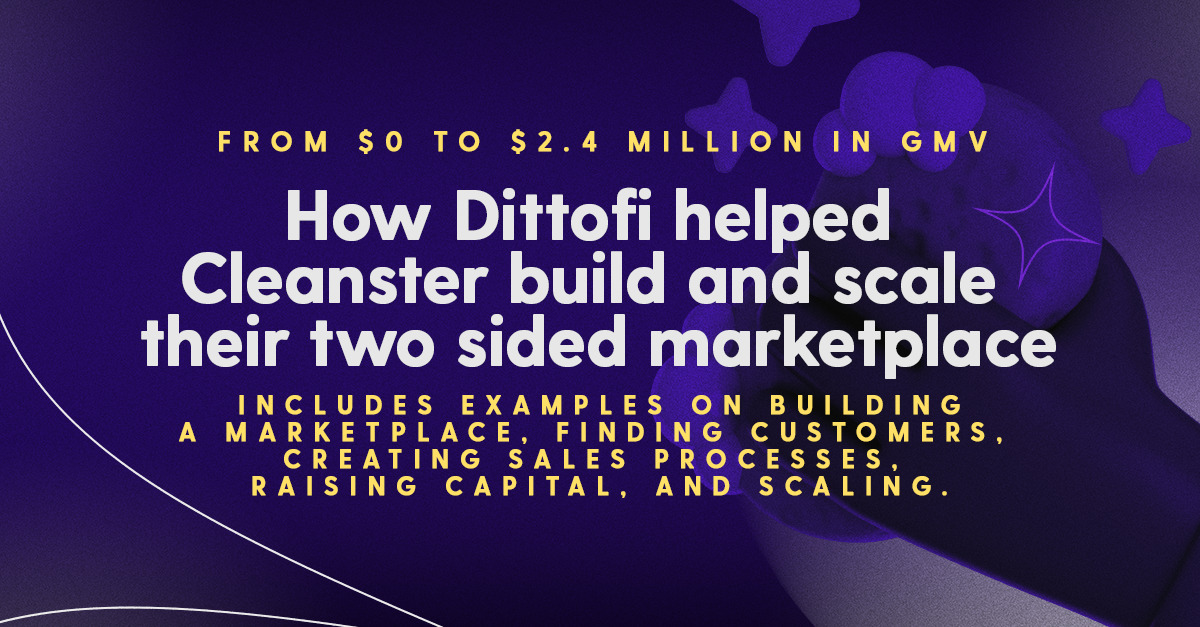Cleanster is a two sided marketplace technology.
The solution connects cleaning professionals with property managers in the United States and Canada.
The goal of the company is to be like the “Uber of cleaning”, where property managers can push a button to order a cleaner.
Cleanster was founded in 2017 by Derrick Agyiri and Gloria Oppong. In 2019, the team started work with Dittofi’s founding team to help resolve challenges ranging from client acquisition to roadmap and new feature development.
Like all successful startups, Cleanster’s journey is ongoing. In 2024, the platform has now transitioned from a startup marketplace to a medium sized marketplace that does more than $2.4 million in Gross Merchandise Volume (GMV).
In this article we cover the steps that Cleanster took in order to build out their marketplace solution and scale.
This includes:
How Cleanster was founded: A lesson learnt the hard way
Cleanster was founded by Derrick Agyiri and Gloria Oppong in 2017.
The company was a spin off from a marketplace business called AceBy that Derrick and Gloria had founded 2 years earlier.
AceBy was a marketplace that aimed to connect all kinds of service providers with local businesses. This includes home services, translation, IT & networking, legal, design and much more. One of the original adverts for the AceBy marketplace is shown below.
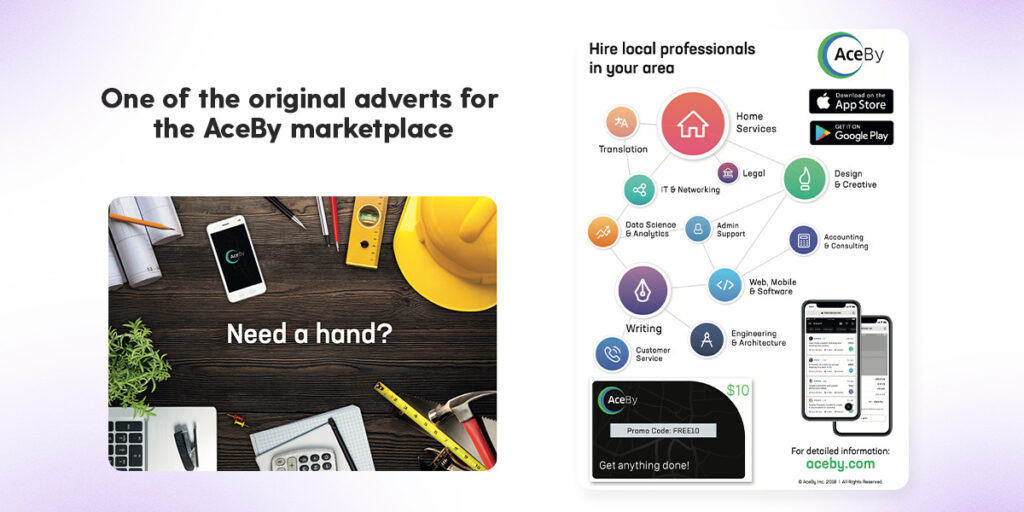
AceBy had one major problem, this was that it had tried to appeal to too many people, all at one.
This broad value proposition failed to consistently attract marketplace buyers or sellers.
As a result, Derrick and Gloria struggled to create marketing material that was able to attract a large enough audience. Furthermore, from the audience that they did attract, they found that each type of service required a more nuanced set of features. This led to high development costs and difficulties supporting clients.
Marketplace founders tip
A common mistake new marketplaces make is focusing on a breadth first rather than a depth first approach. Remember – it’s better to have 100 users who are fanatical your marketplace than 1 million users who just kind of like your marketplace.
After a lot deliberation and consulting with fellow founders, Derrick and Gloria decided to pivot their marketplace to focus on a single niche marketplace idea. This was to connect cleaning professionals with property managers.
To do this, they set up a new company called Cleanster, and began looking for ways to rebuild their technology.
How Cleanster developed their business model
Cleanster’s original business model had been to charge 2.5% commission on all service contracts. At this rate, cleaners booked through their marketplace at $19 per hour, were bringing only 0.47 cents of revenue back to Cleanster. This was nowhere near enough to sustain the business.
At this point, Cleanster started working with Dittofi’s co-founder James Virgo who suggested that Cleanster test out different prices for their cleaners.
Marketplace founders tip
Using Dittofi’s no-code marketplace technology, it’s very easy to adjust marketplace commission rates. You can do this from within Dittofi’s marketplace dashboard, just by entering in different commission rates charged to either the buy side, sell side or both. An example of this is shown below.
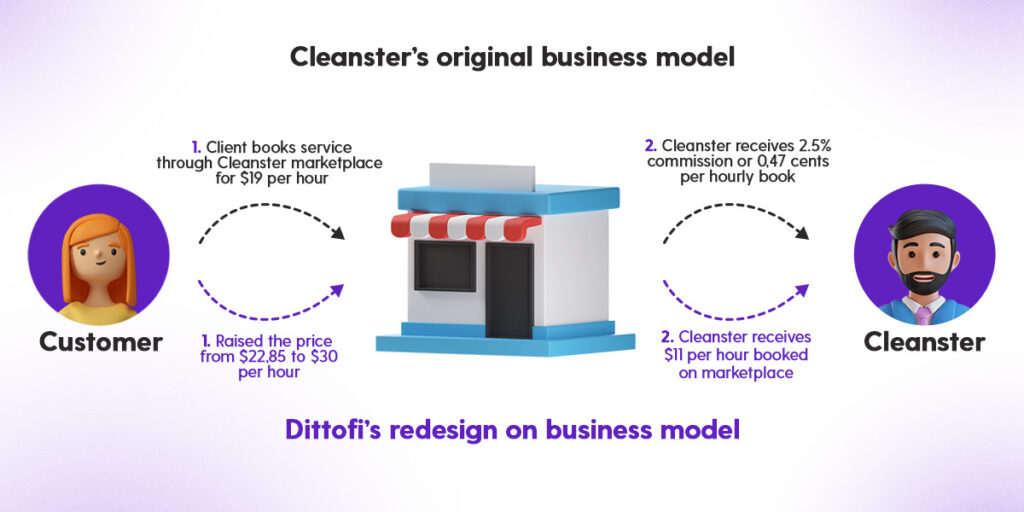
With the help of James, Cleanster increased their commission gradually. They started at 15% and ended up at 58% commission charged on a one hour cleaning.
This raised the price per hour of cleaning from $22.85 to $30 per hour. At this higher price, the team saw that property managers were still willing to pay for an on demand cleaning service and so kept the percentage at the higher rate.
Cleanster was now making $11 per hour revenue compared to the 0.47 cents per hour they had made while running their old business model.
”I led the sales effort for Cleanster in 2019. The impression that I got was that Cleanster’s co-founders were so focused on closing new business, that they had inadvertently set their price way for their service way too low.
To test this, I tried presenting their property managers higher and higher platform fees. I found that at $35 per hour, only around 5% of property managers booked a cleaning through the platform, whereas at $30 per hour almost everyone agreed. So that’s where Derrick and Gloria stuck the price at.”
James Virgo, Co-Founder Dittofi
How Cleanster found their first clients
Since marketplaces need both buyers and sellers, this poses a unique challenge known as the marketplace chicken and egg problem.
The marketplace chicken and egg problem says that without buyers there is little incentive for sellers to sign up and list their services. Meanwhile without sellers, there is no reason for buyers to sign up.
To solve this problem, you just need to pick one side of the marketplace and focus on driving this traffic to your site. Once you have this traffic consistently visiting your site, you can start focusing on attracting the other side of the market.
Generally speaking, it’s best to start by focusing on the hardest side first. In the case of Cleanster, the team decided to sign up a roster of cleaners who would be our core service providers. Once the cleaners were found, the team would then focused on finding property managers.
To find the cleaners, Gloria set up a community on Facebook. She then reached out to thousands of people and asked them to join the group. Once they were in the group, she would advertise to the group the possibility of making money by signing up to Cleanster.
From a technology perspective, Cleanster developed in app onboarding forms to collect up the cleaners details. These forms were customized so as to collect up cleaners’ passport pictures and run automatic background checks on new cleaners.
Marketplace founders tip
With Dittofi you can jump straight in to onboarding your sellers. This is because Dittofi’s marketplace technology includes prebuilt onboarding forms that you can quickly customize for any type of marketplace suppliers, without requiring you to write any code. Screenshots of these are shown below.
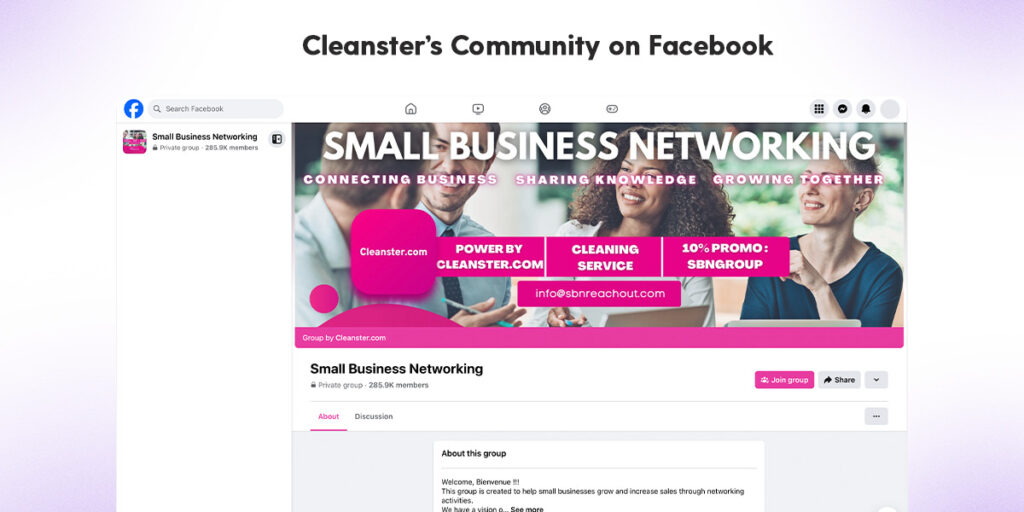
Once Cleanster had collected up their core roster of cleaners, the next step was to find property managers.
To do this, the team created adverts which were posted onto platforms where property managers typically looked for cleaners. This included CraigsList, Angie’s List and Kijiji. These adverts were very simple and included a phone number that property managers could call.
When a property manager called, one of the core team would answer and discuss the size of the opportunity. The team would then set up a time to visit the property manager at one of their properties to meet them in person.
Dittofi was heavily involved at this stage since, meeting the property managers allowed the team to build a robust product development roadmap.
“The in person meetings were great because they allowed us to quickly build up a deep relationship with the property managers. This built immediate trust, but also allowed us to understand exactly what they were looking for.
The property managers wanted to be quoted a price based on the number of rooms, open spaces vs obstructed space, the number of appliances and so on. They also wanted direct communication with the cleaners and for cleaners to send them photographs before and after the cleaning.
These meetings allowed us to quickly activate the platform’s early adopters and build out Cleanster’s development roadmap.”
Dittofi co-founder, James Virgo.
After the in person meetings, the Cleanster team would present their marketplace technology to the property managers and help them make their first booking through their online marketplace.
Building a marketplace sales funnel
Now that Cleanster had some early adopters, it was time to start building out a more automated sales funnel.
For those of you who are not familiar with the concept of a sales funnel, the image below gives a quick pictorial representation of a typical marketplace sales funnel.
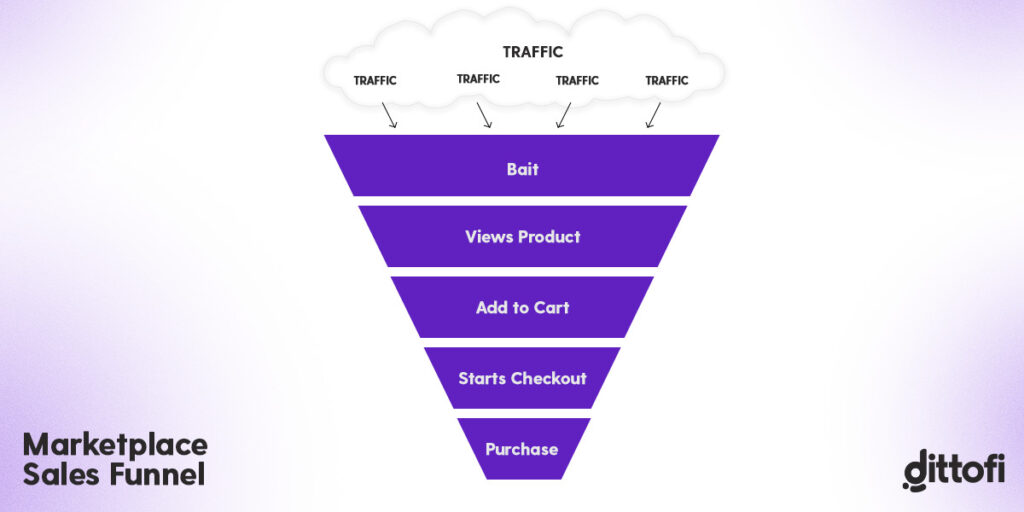
On the image above, there is a cloud at the top of the funnel. This cloud represents all of the potential users of the marketplace.
In the case of Cleanster, this traffic was hanging on on social media platforms such as Facebook, Instagram, property manager forums and gig websites like Canada’s Kijiji. With marketplaces, you need to build two distinct sales funnels, one for buyers and one for sellers.
In the case of Cleanster, the team designed two types of “bait”. The first type was designed to attract cleaners and the second type, property managers. An example of these ads are shown below.
These ads were designed to catch the attention of the cleaners and property managers. Once the individual had their attention caught, they were then redirected the Cleanster website or app where would sign up to the marketplace using their email address.
Once the cleaner or property manager signed up, the Cleanster team collected their emails and, using marketing integrations to HubSpot and SendGrid, the team automated email communications with the customers. These emails were designed to activate and nurture cleaners and property managers.
Marketplace founders tip
You can use Dittofi’s marketplace technology to set up marketing integrations. This includes integrations into Hubspot, SendGrid, Mailchimp and more. These will allow you increase activation rates of your users which will in term help you to increase the number of transactions on your marketplace.
How Cleanster raised capital
All funding rounds require a lot of effort.
You have to connect with hundreds of different VC firms and angel investors in order to find the perfect fit. In Cleanster’s case the fund raising journey can be broken down into three phases.
Phase 1 - Government funding
Before you can get funding, you need to demonstrate that you are able to build and sell a product.
To do this Cleanster built their online marketplace MVP. As we have seen, they then developed their business model and found their first few clients.
After this, the team built a business plan and approached different government entities that support entrepreneurs. The company did this in Quebec, Canada. After trying a few places, they successfully raised $25,000 from Futurpreneur.
Phase 2 - Accelerator funding
Once Cleanster had a small amount of funding, they decided to use this to refine their marketplace MVP and develop their sales funnels. They also experimented with new sales funnels including using micro influencers which further increased their user base.
Once they had more users, they started to aggressively apply for different incubators and accelerator programs. They were rejected from month incubators and accelerators; however, they were eventually accepted onto the Sputnik accelerator in Austin, Texas. This accelerator gave them $100,000 and critical training on how to set up their business for scale.
Phase 3 - Venture Capital funding
After completing the Sputnik accelerator, Gloria and Derrick continued to refine their marketplace product and customer acquisition strategies. With increasing usage, the duo were then able to eventually get to $2.4 million in revenue and raise $1 million in investment capital from Morgan Stanley’s Inclusive Ventures Lab.
To give an idea of how long this took – Cleanster raised their first $25,000 in 2019. It then took 3 years to raise $1 million from Morgan Stanely in 2022.
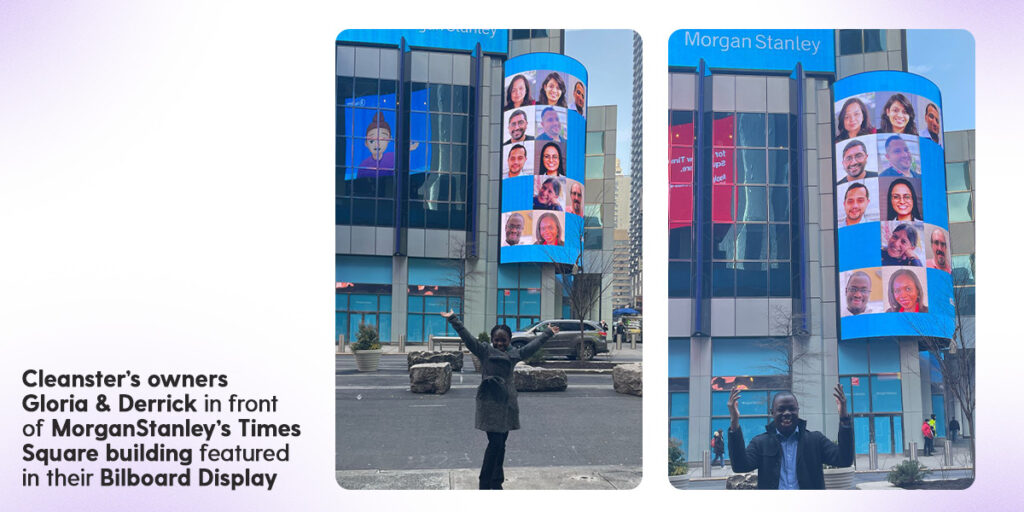
Scaling challenges
According to Reid Hoftman, founder of Linkedin, scaling is the act of “prioritizing speed over efficiency in an environment of uncertainty”.
Mark Zuckerberg captures this sentiment in the mantra, “move fast and break things”.
As Cleanster scaled up their usage, they encountered many different challenges. For example, the company incurred a cost for running background checks on cleaners. Most of the cleaners that signed up never actually got active on the platform. Therefore, the cost of acquiring new cleaners far higher than initially anticipated. This high cost was causing the company to bleed capital and so they made a quick decision to invest in resolving this problem.
To do this, the Cleanster developers needed access to their marketplace source code. This allowed them to resolve the challenge quickly and move forward. As Derrick Agryil, Cleanser Co-Founder recounted, “without access to our source code we would not have been able to adjust our onboarding process fast enough to survive”.
Dittofi is currently the ONLY no-code marketplace builder that operates a unique hybrid approach that combines the speed of no-code, visual development with traditional code. In our unique hybrid model, Dittofi transforms all visual marketplace edits into full stack code. This allows you to build at the speed of no-code but, we also let your developers retain access to the code that powers your marketplace which is essential as you scale.
Conclusion: Build your marketplace MVP
At Dittofi, we supported Cleanster through their journey from idea through to capital raise.
We saw how hard the Gloria and Derrick had to work in order to develop their two sided marketplace.
The first step to getting started is to build your marketplace MVP. Dittofi has developed a marketplace technology that makes this much easier and less expensive than traditional development.
This technology gives you all of the foundational features that you need to launch a two sided marketplace. This includes all of the basics such as a robust peer to peer transaction flow, marketplace hosting, payments and so on, as well as more advanced features such as marketing integrations.
If you’re thinking about building a marketplace, sign up to Dittofi and install one of our marketplace templates.
If you need any help getting started? Book a call with one of our marketplace specialists who we will show you how to build your marketplace today.
Become a Marketplace Insider
Join our inner circle for exclusive insights, coveted trade secrets, and unparalleled strategies – your journey to marketplace dominance begins here.

